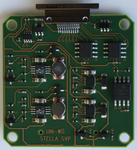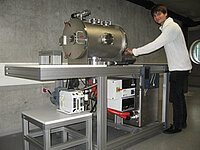STELLA
The STELLA project, which is funded by DLR (FKZ 50RM0901), deals with the development and qualification of a miniature star tracker for pico and nano satellites. STELLA fulfills all relevant boundary conditions and requirements of pico and nano satellites: dimension, mass, power consumption. Overall configuration and performance parameters such as accuracy are tailored such, that they are suitable for the pico and nano satellite class, including the cost point of view.
Overview
Small satellites have become very popular because of their particular advantages like a small mass and beneficial launch costs. Pico and nano satellites, which have total mass between 1-20 kg, represent specific and very young class of spacecrafts. The satellites of this class can be used for a wide variety of applications, such as technology demonstration, testing of materials and components, education purposes, etc. These satellites are trendsetter in miniaturization of satellite components.
The accuracy of the attitude determination of pico and nano satellites is limited by the sensor and actuator system. In most pico and nano satellites the sensor system consists of sun sensors and magnetometers. Even though these sensors are small and optimally suited for the assembly of the small satellites, they feature low accuracy performance.
As an alternative, star trackers can be used for a very accurate attitude estimation of a satellite. Star trackers compare star sky images with star catalog references in order to recognize a star pattern and to compute an orientation of the spacecraft. For years this technology has been reliably used in big satellites. Unfortunately the common star trackers are too large and heavy to be integrated into pico and nano satellites.
STELLA star tracker has been developed especially for pico and nano satellites. Its parameters are well adapted to dimension, mass, power requirements of this satellites class.
| STELLA star tracker |
The sensor has several advanced capabilities such as recognition of interferences from the Sun, Moon and the Earth, on orbit software upload ability and partial hardware redundancy. The modular design allows mounting the optical and electrical parts separately to provide flexible integration in the satellite structure.
Particular Features of STELLA
STELLA has several specific features and unique characteristics, which enables practical and robust usage and simple in system integration.
- Entire software reload for all embedded processors offers the possibility to update or replace through radiation effects damaged program code.
- Lookup table update and parameterization of ADA via TC provide comfortable option to change the algorithms settings.
- Parameterization of image sensor by TC allows adaptation of system to environment.
- Particular parts of algorithm can detect interference from Sun, Earth and Moon.
- For Evaluation of ADA raw image can be downloaded.
- The critical components in power and communication system are redundant.
- Modular structure: Sensor head can be mounted separately from residual electronics.

 |  |
| Results validation: Night sky image (inverse), Star tracker output, Simulation results: q1 = -1153; q2 = 4903; q3 = -1450; q4 = 8515 (x10-4) | |
The project was finished in 2012 with the qualification of STELLA including thermal-vacuum, vibration, shock and radiation test and functional test with simulators and on the real night sky.







